Disclosure: We may earn commissions if you purchase products after clicking on a link from our site.
If you want to learn how to deer hunt in ground blinds, you’ll want to read on for the best tips and tricks. Ground blinds offer several advantages over traditional deer hunting methods, and can be an extremely effective way to take down deer.
In this article, we’ll discuss how to set it up for optimum concealment and how to hunt from one. So whether you’re a seasoned pro or just starting, read on for the best tips and tricks for deer hunting in ground blinds!
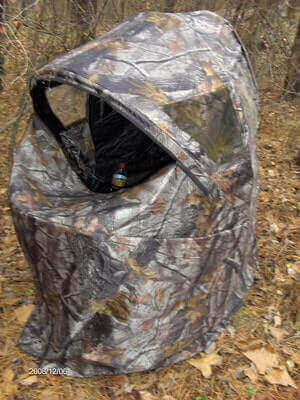
Table of Contents
- 1 How To Deer Hunt In Ground Blinds
- 2 1. Pre-Season Scouting
- 3 2. Set Up Ground Blind In Advance
- 4 3. Camouflage It
- 5 4. Weather-Ready
- 6 5. Use Scent-Free Products
- 7 6. Wind Direction
- 8 7. Be Quiet and Still
- 9 8. Wait For The Right Shot
- 10 9. Use Decoys
- 11 10. Use a Pop-Up Blind
- 12 11. Always Be Adjusting
- 13 12. Get Comfortable With Your Equipment
- 14 13. Don’t Be Predictable
- 15 14. Be Patient
- 16 The Bottom Line
How To Deer Hunt In Ground Blinds
1. Pre-Season Scouting
It is very important that you scout the area you want to set up your ground blind. Pre-season scouting is crucial to your success in deer hunting in ground blinds. Scouting the area will give you information about travel routes, feeding, and bedding areas. You will also learn the wind direction in that area. With this information, you can then decide the best spots to place ground blinds to get deer. We discussed the best whitetail deer hunting tips in this article and you can read it from this link.
Trail cameras can also be set up to give you more information about the area. You won’t be there 24 hours a day. Therefore, with a trail camera, you can get more information on the deer in that area than the hours of scouting. The best trail cameras on the market today were reviewed to help you find the right one.
Additionally, if you scouted the area previously, the danger is relying on that information from previous years. Deer behaviors and routes may have changed. With the increased presence of predators, weather changes, etc., the movement of deer may have also been altered.
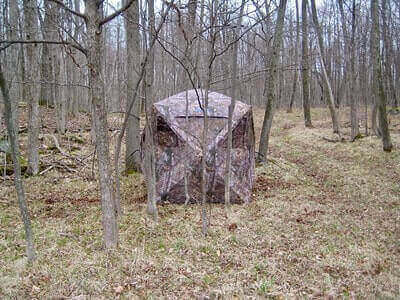
2. Set Up Ground Blind In Advance
After you have scouted the area and decided where to set up your ground blind, it is important that you set it up well in advance of the hunting season. This will allow you to properly set it up and let it blend with the area. Setting it up ahead of the hunting season also allows the deer and other animals in the area to get accustomed to the ground blind.
After some time, it will not stick out to them like an odd thing. Additionally, setting up the blind ahead of the hunting season will also allow the scent to be neutralized in the area.
3. Camouflage It
It is important that the ground blind blends with the area. You have to do a good job of camouflaging it. If deer can easily spot the blind, they will sense danger and avoid it. Ground blinds are usually camouflaged, but you also need to work on blending them with the surrounding area using trees, shrubs, and foliage of that area.
4. Weather-Ready
Preparing the ground blind to withstand various weather conditions is crucial when learning how to hunt deer effectively. Weather can significantly impact the success of a hunt, making it essential to ensure that the blind is weather-ready.
This involves several key steps, such as reinforcing the blind’s structure to withstand strong winds, sealing any gaps or openings to prevent rain or snow from entering, and waterproofing the fabric to repel moisture.
Additionally, securing the blind to the ground with stakes or weights can prevent it from being blown away during windy conditions. By taking the time to weatherproof the ground blind, hunters can create a comfortable and safe environment for themselves while increasing their chances of success in adverse weather conditions.
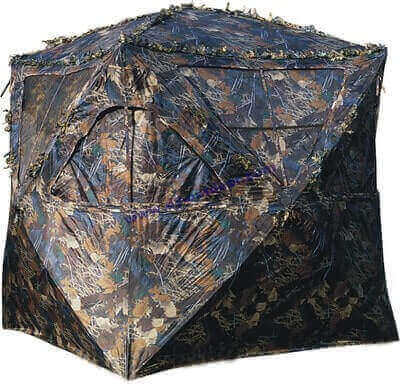
5. Use Scent-Free Products
When learning how to hunt deer in ground blinds, using scent-free products can significantly increase the chances of a successful hunt. Deer have a keen sense of smell and can easily detect human odors, which can alert them to the presence of hunters. By using scent-free soaps, detergents, shampoos, and clothing, hunters can minimize their scent and avoid spooking deer.
Additionally, using scent-free sprays or cover scents can further mask any remaining human odors and help hunters blend into their surroundings. By taking steps to eliminate or minimize scent, hunters can increase their chances of remaining undetected and getting closer to their target deer while hunting from ground blinds.
6. Wind Direction
When learning how to hunt deer in ground blinds, understanding the wind direction is crucial for a successful hunt. Deer heavily rely on their sense of smell to detect predators and danger. If a hunter sets up a ground blind with the wind blowing towards where they expect deer to come from, their scent will be carried away from the deer, reducing the chances of detection.
Conversely, if the wind is blowing towards the deer, the hunter’s scent will be carried directly to them, likely causing them to spook and flee before the hunter has a chance to take a shot. By paying attention to wind direction and strategically positioning their ground blind accordingly, hunters can minimize the risk of being detected by deer and increase their chances of a successful hunt.
7. Be Quiet and Still
When learning how to hunt deer in ground blinds, being quiet and still is paramount for success. Deer have incredibly sensitive hearing and can easily detect even the slightest noises. Rustling leaves, snapping twigs, or even the sound of breathing too loudly can alert deer to the presence of a hunter.
Additionally, sudden movements can startle deer and cause them to flee before a shot can be taken. Therefore, hunters must remain as quiet as possible and minimize any unnecessary movements while inside the ground blind.
This means speaking in hushed tones, avoiding fidgeting, and using slow, deliberate movements when adjusting equipment or preparing to take a shot. By staying quiet and still, hunters can increase their chances of remaining undetected by deer and improve their overall hunting success.
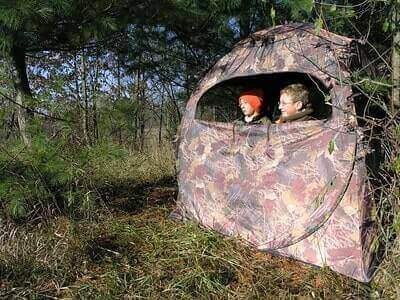
8. Wait For The Right Shot
When learning how to hunt deer in ground blinds, waiting for the right shot is crucial for ethical and effective hunting. Patience is key, as rushing a shot can result in missed opportunities or, worse, poorly placed shots that injure rather than cleanly kill the animal.
Hunters must wait for the deer to present a clear and ethical shot opportunity, ideally broadside or quartering away, with vital organs exposed. Taking time to assess the deer’s behavior, movement patterns, and positioning relative to the blind allows hunters to make informed decisions about when to take the shot.
Additionally, waiting for the deer to be within an appropriate distance ensures greater accuracy and effectiveness of the shot. By exercising patience and waiting for the right moment, hunters can increase their chances of making a clean and humane harvest while minimizing the risk of injuring or losing the animal.
9. Use Decoys
Deer are curious animals. They observe changes, and new things and always go to investigate them. Use their curiosity against them by employing decoys to lure them to your location.
When learning how to hunt deer in ground blinds, using decoys can be an invaluable strategy for attracting and luring deer within range. Decoys simulate the presence of other deer, arousing curiosity or triggering territorial instincts in live deer nearby.
By strategically placing decoys within sight of the ground blind, hunters can increase the likelihood of deer approaching within shooting range. Decoys can also serve as a distraction, drawing a deer’s attention away from the hunter’s location, and allowing for a more stealthy approach or shot.
However, it’s important to use decoys judiciously and by local hunting regulations, as improper placement or overuse can spook deer rather than attract them. Additionally, using scent-free products and ensuring that the decoys blend seamlessly into the natural surroundings can enhance their effectiveness.
Overall, incorporating decoys into ground blind hunting tactics can significantly improve the chances of a successful hunt by increasing deer activity in the area and providing hunters with more opportunities for a clean shot.
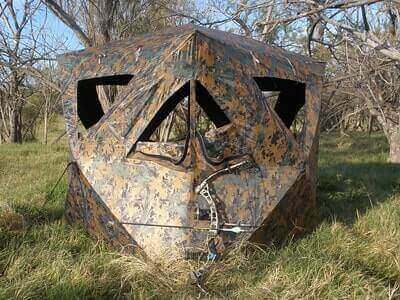
10. Use a Pop-Up Blind
When learning how to hunt deer in ground blinds, using a pop-up blind can significantly enhance the hunting experience and increase the likelihood of success.
Pop-up blinds offer several advantages, including portability, ease of setup, and concealment. Their lightweight and collapsible design makes them easy to transport to different hunting locations and set up quickly without disturbing the surrounding environment.
Once deployed, pop-up blinds provide hunters with a concealed and comfortable vantage point from which to observe deer activity and await the perfect shot. The enclosed space of a pop-up blind helps to mask movement and scent, reducing the likelihood of detection by wary deer.
Additionally, pop-up blinds offer protection from the elements, shielding hunters from wind, rain, and cold temperatures, allowing for longer and more comfortable hunting sessions. Overall, incorporating a pop-up blind into ground blind hunting tactics can improve concealment, comfort, and overall hunting success.
11. Always Be Adjusting
Deer are constantly moving and you must be prepared to adjust at any moment. When learning how to hunt deer in ground blinds, it’s crucial to understand that deer are constantly on the move, and as a hunter, you must be prepared to adjust your tactics accordingly.
Flexibility and adaptability are key traits in successful hunting, especially when hunting from a ground blind. Deer may change their patterns, feeding areas, or travel routes based on various factors such as weather, food availability, and human activity.
Therefore, hunters must be ready to shift their position, change their calling strategies, or relocate their blind if necessary to stay within range of deer activity. Being observant and responsive to these changes can greatly improve your chances of encountering deer and making a successful harvest. Additionally, remaining patient and persistent while adjusting your approach will ultimately lead to more fruitful hunting experiences in ground blinds.
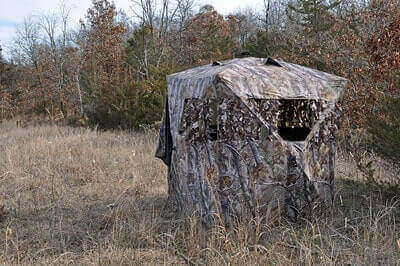
12. Get Comfortable With Your Equipment
When learning how to hunt deer in ground blinds, one of the most critical aspects is getting comfortable with your equipment. Familiarity breeds confidence, and confidence is key to success in hunting.
Whether it’s your firearm, bow, range finder, or other gear, knowing your equipment inside and out allows you to operate it effectively and efficiently in the field. Practice shooting from your ground blind to ensure you can smoothly maneuver and take accurate shots when the moment of truth arrives.
Additionally, familiarize yourself with any accessories such as shooting sticks or bipods that you may use to stabilize your shots. Being comfortable with your equipment not only enhances your shooting proficiency but also minimizes the chances of mistakes or malfunctions that could cost you a shot opportunity. Therefore, dedicating time to practice and fine-tune your gear is an essential step in becoming a successful deer hunter in ground blinds.
13. Don’t Be Predictable
When learning how to hunt deer in ground blinds, it’s crucial not to be predictable in your movements and patterns. Deer are incredibly wary animals and can quickly pick up on human presence if they detect a consistent routine.
Therefore, it’s essential to vary your hunting strategies, including the times you hunt, the locations you choose for your ground blinds, and even the routes you take to access your hunting spots. By keeping deer guessing and avoiding establishing predictable patterns, you increase your chances of catching them off guard and having successful hunts.
Additionally, changing up your hunting approach allows you to adapt to different environmental conditions, deer behaviors, and hunting pressures, maximizing your opportunities to encounter deer and make successful harvests. So, embrace versatility and unpredictability in your hunting tactics to outsmart deer and increase your chances of success in ground-blind hunting.
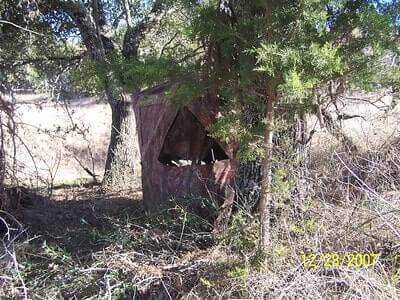
14. Be Patient
Patience is a virtue when it comes to learning how to hunt deer in ground blinds. It’s easy to get restless or discouraged, especially during long hours of waiting for deer to appear.
However, patience is essential because deer movements can be unpredictable, and success often comes to those who wait. By remaining patient and staying focused on the task at hand, hunters give themselves the best chance of encountering deer and making a successful harvest.
Additionally, patience allows hunters to observe deer behavior, learn from their surroundings, and make informed decisions about when to take a shot. Rushing or becoming impatient can lead to mistakes, missed opportunities, and ultimately, frustration. Therefore, embracing patience as a fundamental aspect of hunting from ground blinds can lead to more enjoyable and successful hunting experiences in the long run.
The Bottom Line
Using ground blinds to hunt deer is a great strategy. They can easily be set up and taken down. Moreover, they provide good cover for hunters and help block your human scent.
In this article, we have discussed how to hunt successfully with a hunting ground blind. You can read about the best hunting ground blinds available today to help you choose the right one for you. You can also read the best hunting chairs, the best deer feeders, and the best hunting knives.